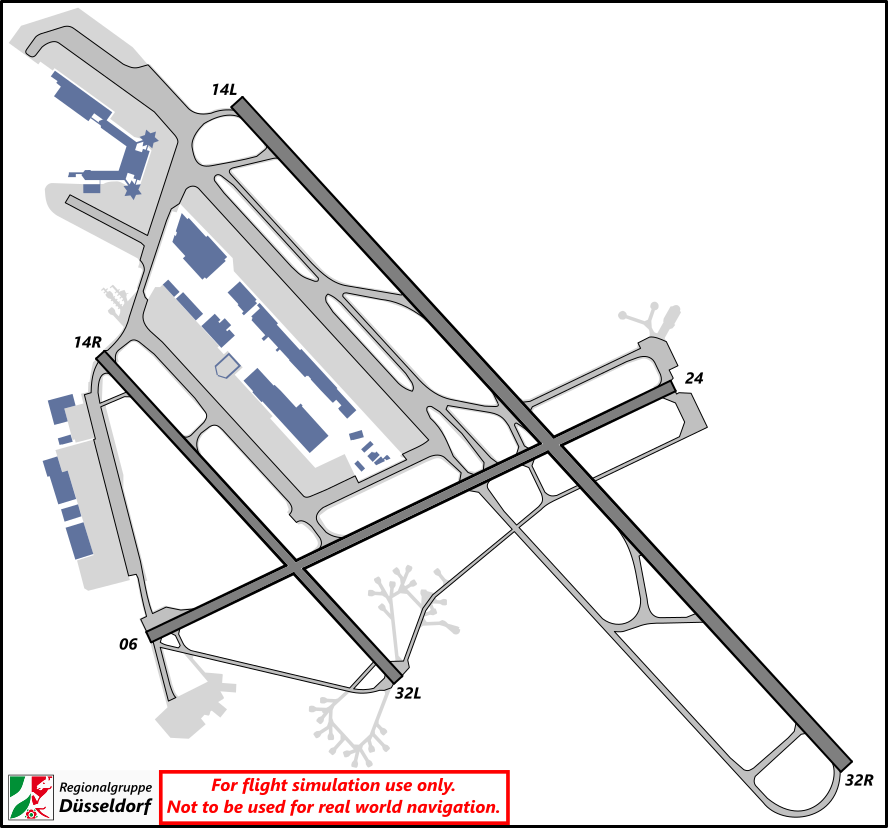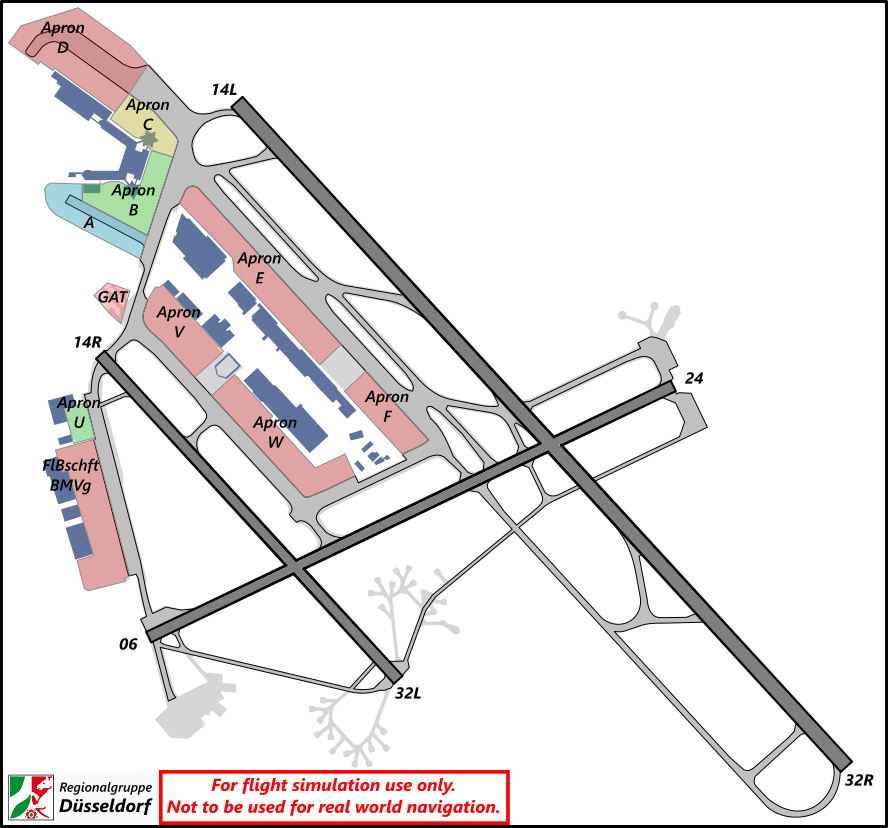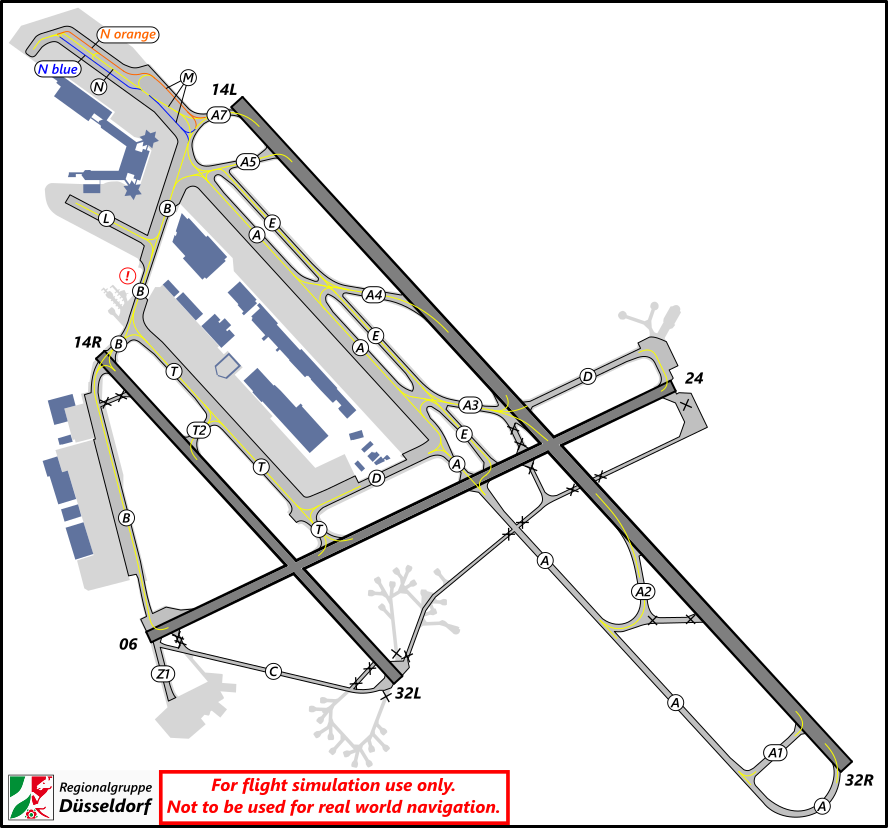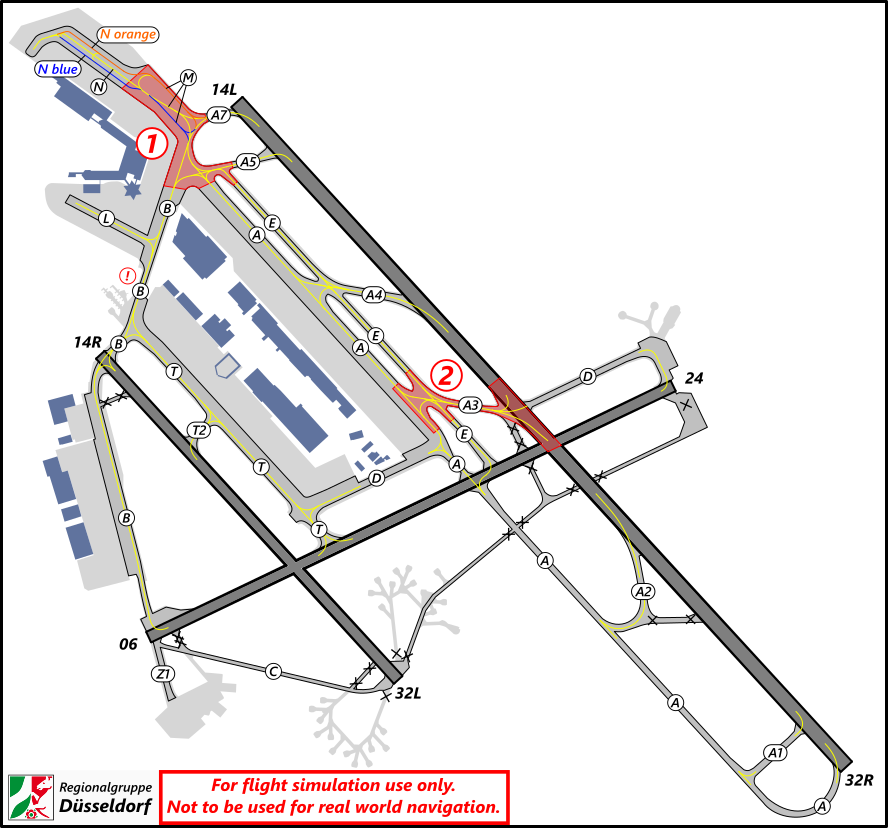Ground
Airport layout
Cologne-Bonn airport has three crossing runways.
The main take-off and landing direction is 32, whereby runway 32R is primary used due to the available length. Business jets or VFR traffic can also use runway 14R/32L for shorter taxi times. During high traffic situations it is recommended to use runway 14L/32R and runway 24 only.
The airport has two passenger terminals. Terminal 1 with its two distinctive stars accommodates aprons A, B and C, and Terminal 2 with the apron area D.
The cargo area is used by several airlines and is located in the middle of the airport between the runways. It contains the apron areas E, F and W.
Apron V close to the cargo area is used for general aviation and business jets.
The military part of the airport is located west of runway 14R/32L at apron U. The military part of the apron is the home of the german Flugbereitschaft.
Area of Responsiblility
The area of responsibility of Ground is located between the three runways and includes all aprons except the military apron U (see image below).
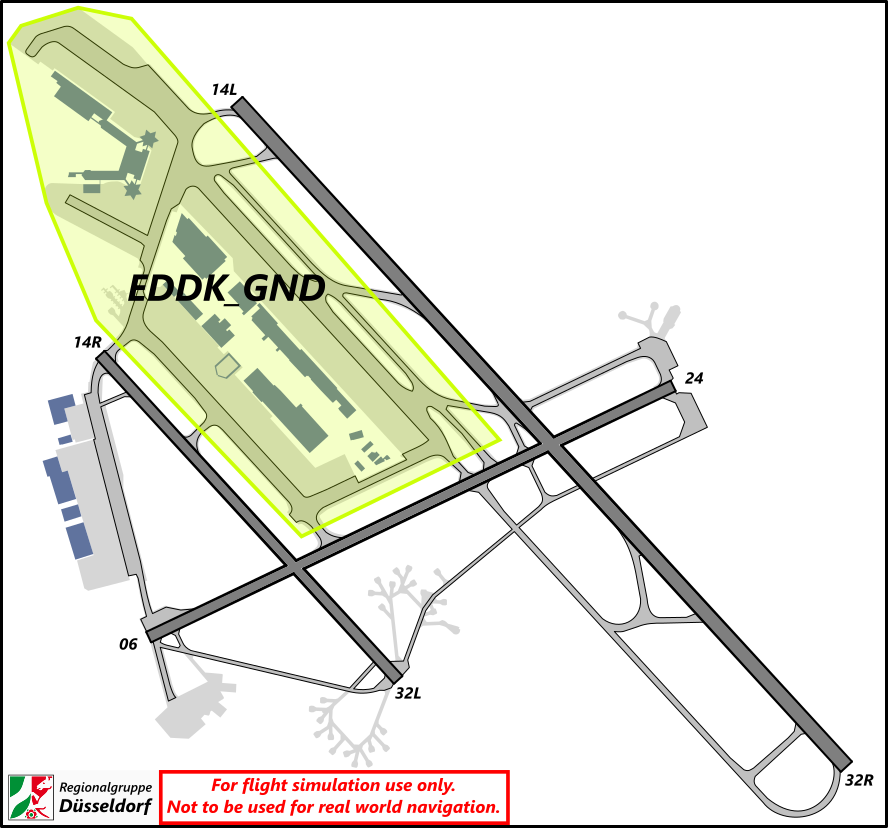 Area of Responsibility - Cologne-Bonn Ground
Area of Responsibility - Cologne-Bonn Ground
Cologne-Bonn Apron: special station that is mainly used for larger events at the airport. It does not have an own area of responsibility and works closely together with Ground. Apron receives the aircraft from Delivery and coordinates with Ground the pushback from the parking positions. For taxi the aircraft are then handed over to Köln Ground.
EWG1TP, pushback approved on the blue line, for taxi contact Ground on 121.725.
Runway Crossing: The crossing of all runways is within the responsibility of Tower, but can be delegated to Ground if the appropriate runway is not in use.
Parking Positions
On aprons A - D, parking positions with even numbers are generally suitable for aircraft up to a Code C, positions with odd numbers can be used by aircraft up to Code E.
On aprons E, F and W, parking positions with even numbers are generally suitable for aircraft up to a Code D, positions with odd numbers may be used by aircraft up to Code E.
Apron A: The parking positions can be reached from taxiway L. Aircraft up to code C can be parked in the parking positions with even numbers. Aircraft up to code E can be parked on the positions with odd numbers.
Apron B: The parking positions are located around the southern and between the two building stars and are reached via taxiways L or B. Parking position B14 be used up to code E and parking positions B23, B27 and B29 to code D. Airlines in this area are primarily Lufthansa or Star Alliance Group.
Apron C: The parking positions are located at the northern end of the building up to the building boundary to Terminal 2. Parking position C50 can be used up to code E. Airlines in this area are primarily Lufthansa or Star Alliance Group.
Apron D: The D positions all belong to Terminal 2. D51, D53, D57 can be used up to code D.
Apron E: The parking positions are usually only used for cargo aircraft. The E positions are home to FedEx and DHL. Parking positions E31, E41 can be used up to code F (A380), parking position E43 to code F (B748F).
Apron F: The parking positions are usually only used for cargo aircraft. The F positions are home to UPS. Parking position F21 can be used up to code F (A380), parking position F23 to code F (B748F). Parking position F34 can be used up to code D (B767-300).
Apron U: Apron U is used by two maintenance companies for customers' aircraft. Parking positions U10-U14 up to code C (A320) and Parking positions U16-U26 for code A.
Apron V: Apron V is used for business jets and general aviation. Depending on the position, aircraft up to the size of a B737-BBJ can be parked.
Apron W: The parking positions are only used by UPS cargo aircraft. Parking positions W10-W22 max. B763, W24-W26 max. MD11 and W28 max. B757-200.
General aviation parking: The general aviation parking is located northwest of taxiway B between the junction of taxiway T and the bridge before the junction of stand taxiway L.
Taxiways
The primary used taxiway is A, running parallel to runway 14L/32R.
Seven taxiways branch off from runway 14L/32R, numbered from taxiway A to taxiway A7, starting at the beginning of 32R (only taxiway A6 is omitted!).
In 14-operation, landing aircraft usually leave the runway via taxiways A3 or A2 and are then guided via taxiway A to the parking area.
In 32-operation, departing aircraft are guided from the terminal to the runway via taxiway A, landing aircraft usually leave the runway via taxiways A3 or A4 and are then guided towards the terminal via taxiway E.
Between L and the GAT (marked with (!)) taxiway B leads over a bridge where only aircraft with a wingspan of max. 52 m (Codeletter D) and max. weight of 200t are allowed to taxi on it's own.
Taxiway C can only be used by Code C aircraft. On taxiway D only Code E aircraft and below are allowed, except the part east of runway 14L/32R where also a B748 is allowed.
In front of Terminal 2 aircraft up to code C can use the orange and blue line simultaneously up to position D51.
Runway 24/06 for taxi: It is possible for in- and outbound traffic to use runway 06/24 for taxi.
GAF1GH, taxi to holding point runway 32R via Bravo, enter runway 06 and Alpha, cross runway 32L
DAFHK, taxi right via runway 24 and continue T
After landing or before takeoff, the word "backtrack" has to be used.
EWG1PC, backtrack runway 24, vacate T
RYR7AF, backtrack and lineup runway 24
Potential conflicts at the ground
(1) When using runway 14L as departure runway, Ground need to take care of not blocking the taxiways B, M, A5 as well as the blue and orange line with departing aircraft for inbound traffic. In high traffic situation outbound traffic might wait short of A, B or by using the colored lines until the inbound traffic has passed before they can continue up to the holding point.
(2) If Runway 24 is used for take-offs, Taxiway A3 may become a bottleneck because aircraft have to be guided to the runway via Taxiways A3 and D, while landing aircraft on Runway 14L/32R could taxi via Taxiway A3.
Tower should inform landing traffic that taxiway A3 is not available for vacating!

